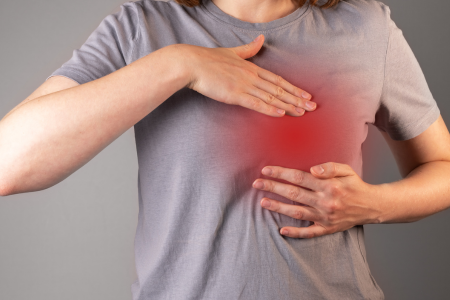In recent years, medical science has taken giant leaps in the realm of cancer treatment. Yet, screening with mammograms hasn’t changed in years. Some are asking why women are willing to sit and wait for enough time to pass to allow cancer to get large enough to be seen on a mammogram. Another technology, thermal imaging for breast cancer detection has been available for decades for much earlier detection of breast cancer. Thermography is a non-invasive and radiation-free method that presents a potentially groundbreaking shift in our approach to breast health.
Breast thermography leverages the heat radiating from the body to identify abnormal patterns and physiological changes, which can be early signs of cancer. Unlike mammography, which primarily detects physical changes, breast thermography identifies functional changes within the breast. Thermography literally sees the heat caused by the inflammation present when cancer is in the earliest stages of development. Mammography waits for the cancer to become large enough to be seen on X-Ray.
This video explores the science behind breast thermography, its potential benefits, limitations, and how it could revolutionize breast cancer screening in the years to come. There are promising possibilities that this technology could contribute to improving early detection and ultimately saving lives.
Breast Thermography for Breast Cancer Screening
This video gives tremendous insight into what is involved in breast thermography for breast cancer screening.
Mammography vs. Thermal Imaging for Breast Cancer Detection: Weighing the Pros and Cons
When it comes to finding early breast cancer early, both thermal imaging and mammography have their unique advantages and potential disadvantages. And, while no one is advocating dropping the recommended screening mammograms just yet, there are many women at high risk who want greater reassurance than what routine mammograms can provide. And yet, aren’t all women at high risk when 1 in 8 women will develop breast cancer? Understanding these can provide valuable insights and inform your healthcare decisions.
The mammography industry is powerful, and no doubt, there are financial interests at play that are affecting the implementation of these technologies. An FDA article was written to warn consumers that thermal imaging is not a substitute for mammograms. Meanwhile, a scientific article states, “This method shows high accuracy and is a cost-effective form of diagnosis.” [PMC9731505]. That article also predicts that thermal imaging sensor technology is advancing and interpretation will continue to improve with the addition of AI to read images more accurately.
Advantages of Thermal Breast Imaging For Breast Cancer Screening:
- Non-invasive and contact-free, unlike mammography which uses physical compression of the breast.
- Radiation-free, providing a safer alternative to methods that expose the patient to radiation, such as mammography.
- Capable of finding physiological changes related to increased blood flow and metabolism, potentially identifying early-stage tumors even before physical changes become apparent.
- Thermal breast imaging is appropriate for women of all ages, including those under 40, who are typically not advised to undergo routine mammograms.
Disadvantages of Thermal Imaging In Breast Cancer Screening:
- Not considered a standalone test for breast cancer screening. Thermal breast imaging is usually used in combination with other tests as it detects physiological changes rather than structural changes.
- Can result in false positives (finding changes that aren’t cancer) or false negatives (missing cancers), raising questions about its sensitivity and specificity.
Advantages of Mammography:
- Mammography is considered the gold standard for breast cancer screening because it is capable of detecting tumors that are too small to be felt.
- Widely accepted, accessible, and covered by most insurance plans.
Disadvantages of Mammography:
Effectiveness is lower in women with dense breasts, where detecting cancer can be more challenging.
- Exposure to even the low levels of radiation in a mammogram are known to poses risks.
- Can cause physical discomfort or pain due to the breast compression involved in the procedure.
It goes without saying that a healthcare provider should be consulted when deciding the best breast cancer screening strategy for you based on your individual risk factors and health history. Both mammography and thermal imaging have their places in overall breast health management.
Your Risk May Factor Into Your Breast Screening Strategy
Some women are at far greater risk for breast cancer than others. Here are is a list of risk factors you should consider:
- Age: The risk increases with age, with most cases diagnosed in women over 55.
- Genetic mutations: Inherited mutations in certain genes, like BRCA1 and BRCA2, greatly elevate risk.
- Family history of breast cancer: Having a close relative with breast cancer can increase risk.
- Personal history of breast cancer: Women who’ve had breast cancer before are more likely to get it again.
- Dense breast tissue: Dense breasts can both increase risk and complicate cancer detection.
- Certain reproductive factors: Early menstruation (before age 12), late menopause (after 55), late childbirth, or never having given birth can raise risk.
- Race and ethnicity: White women are slightly more likely to develop breast cancer than African American women, but African American women are more likely to die from the disease.
- Exposure to estrogen: Extended exposure to estrogen, whether via hormone replacement therapy or certain reproductive patterns, can increase risk.
- Obesity: Being overweight or obese, particularly after menopause, can increase risk.
- Physical inactivity: Regular physical activity can help reduce breast cancer risk.
- Alcohol consumption: The more alcohol consumed, the higher the risk.
- Radiation exposure: Exposure, particularly before age 30, can increase the risk of breast cancer.
- Oral contraceptives: Certain oral contraceptives may slightly raise breast cancer risk.
- Root canals: Some research suggests a link between root canals and increased breast cancer risk, but this is controversial and not universally accepted in the medical community.
To Sum It Up
In critical health screenings for breast cancer detection, both mammography and thermal imaging play pivotal roles. Each technique offers unique advantages and presents potential limitations. There isn’t a one-size-fits-all approach to breast health.
Mammography still holds its place as the widely accepted standard for breast cancer screening. However, we cannot overstate the potential thermal imaging has, particularly for high-risk women, to enhance early detection efforts. It’s non-invasive, radiation-free nature, and has the potential to identify physiological changes before they become structural ones. This makes it a promising complement to traditional mammography, particularly for younger women and those with denser breasts.
The decision on which method to use should always be made in consultation with a healthcare provider. Your provider can help you consider your individual risk factors, overall health, and personal comfort. The goal is to ensure the most effective and comprehensive approach to breast cancer screening.
If we want to advance in catching the most aggressive forms of breast cancer in their earliest stages, it’s clear that a multi-faceted approach using both traditional mammography and thermal imaging will help.
Notice: The NutriScape.NET site is intended for educational purposes and does not constitute the practice of health care advice, diagnosis, or treatment. Individuals should seek the advice of a qualified healthcare provider for any questions regarding personal health or medical conditions. Access to independently licensed Registered Dietitian Nutritionists can be found through our Telenutrition site.

 Scan Me!
Scan Me!


